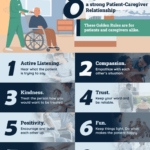Diabetes affects 34.2 million Americans, —10.5% of the population. Of those diagnosed with diabetes, 14.3 million, 26.8%, are Americans age 65 and older.
Although these numbers are staggering, lifestyle choices can help mitigate the disease’s impact on patients’ lives. The ideal situation would be to focus on a healthy diet and proper exercise as early as possible to avoid the diagnosis altogether. Thankfully, our knowledge of the disease and the tools to manage health has come a long way, so it is possible to balance our health needs and live a fruitful life while living with diabetes.
There are three types of diabetes:
- Type 1 diabetes is when the body does not produce insulin. Insulin is a necessary hormone for breaking down the sugar we consume and converting it into glucose. Glucose is the energy that fuels our bodies. This type of diabetes is most common in young people.
- Type 2 diabetes is when your body doesn’t use insulin properly. In this case, you may need medicine or additional insulin to manage your diabetes. Type 2 diabetes is more common in older people.
- Gestational diabetes occurs in a pregnant woman. In most cases, this form of diabetes goes away after birth; however, those with gestational diabetes have a greater chance of developing type 2 diabetes later in life.
Diabetes can impact different parts of your body. Over time, it can cause health problems such as heart disease, stroke, kidney disease, eye problems, and nerve damage. People with type 2 diabetes are also at greater risk of developing cancer and Alzheimer’s disease.
According to the National Institute on Aging, “millions of older Americans have ‘prediabetes.’ This means their glucose levels are higher than usual but not high enough to be called diabetes. People with prediabetes have a greater chance of developing type 2 diabetes and having a heart attack or stroke.” There are no exact symptoms of prediabetes, so you can develop it and not know it. The majority of the time, people develop prediabetes long before they develop type 2 diabetes. Exercise and diet play a large part in how well someone manages the disease or prevents it altogether.
Managing Your Diabetes
Your healthcare management plan should be a joint effort between you and a doctor. Even if you know what type of diabetes you have, your individual health needs will vary, so it’s essential to maintain an open communication line with a healthcare provider.
The most critical elements to managing your diabetes are diet and exercise. Those with diabetes need to make smart and healthy food choices because what you eat affects your glucose levels. It would help if you had a clear idea of what to eat, as well as how often. Being active also helps improve glucose levels in older people and can include simple exercises such as daily walks. The most important aspect of being active is integrating as much physical activity into your routine as possible. Moving around the house to do chores (if you are physically capable), walking daily and replacing car rides with walks, stretching, and even playing with grandchildren or pets, are all forms of physical activity that can help maintain good physical
health, even if you cannot incorporate traditional exercises.
Two other important factors in managing your diabetes are to track your glucose levels and take your medicines on time. Both high and low glucose levels put your health at risk. Tracking your levels will impact how, what, and when you eat. Finally, take your prescribed medicines even if you feel good and inform your doctor if you have any side effects.
Caretakers responsible for patients with diabetes should help keep track of medication schedules and work with their patients to identify nutritional foods that patients will enjoy. You can make an activity out of planning meals, shopping, and preparing food together. It is an enjoyable and supervised pastime that encourages patients to take ownership of their health while keeping them busy and engaged.












